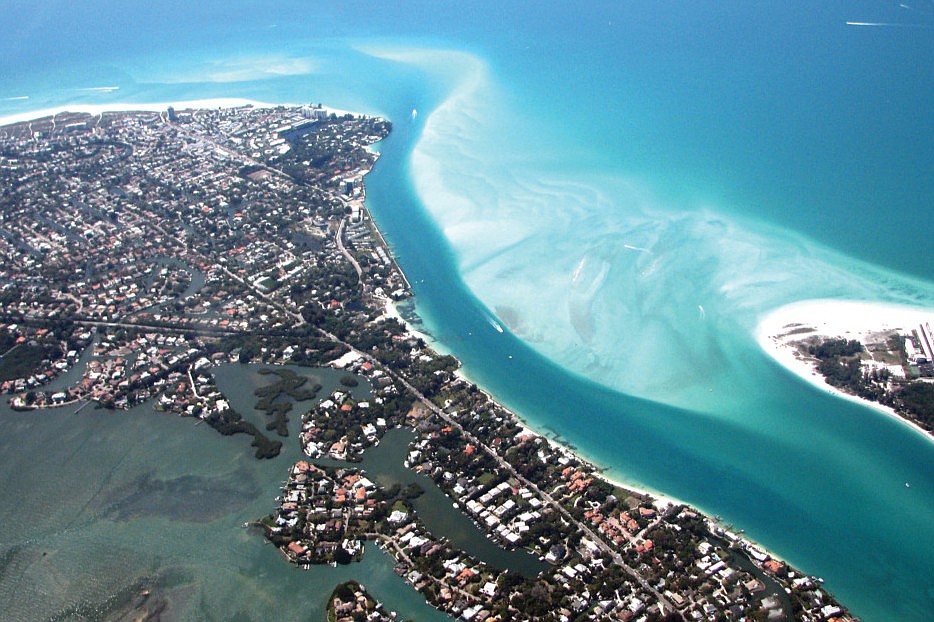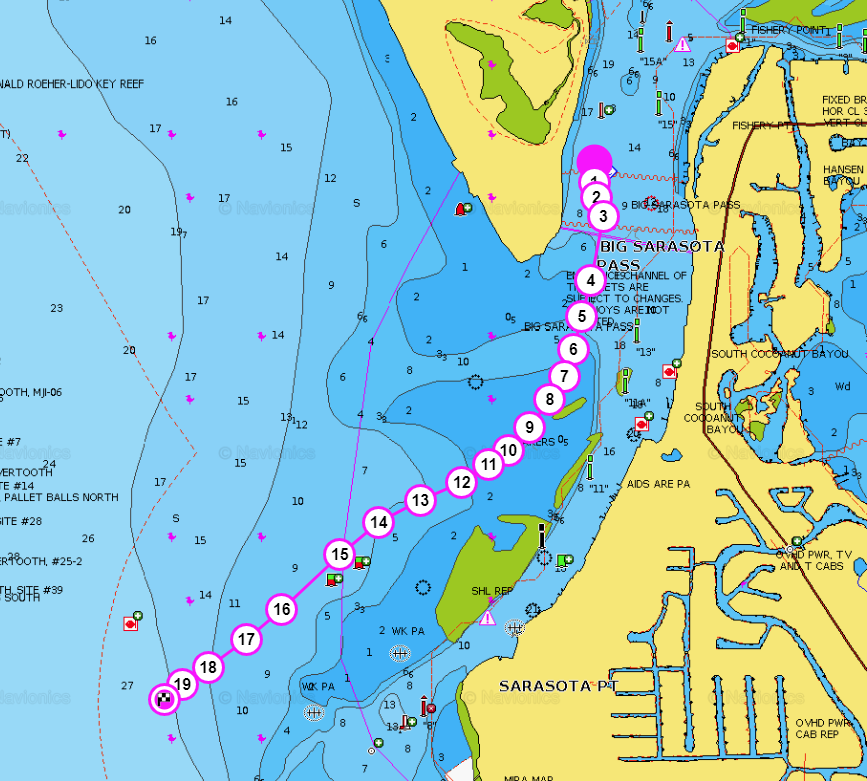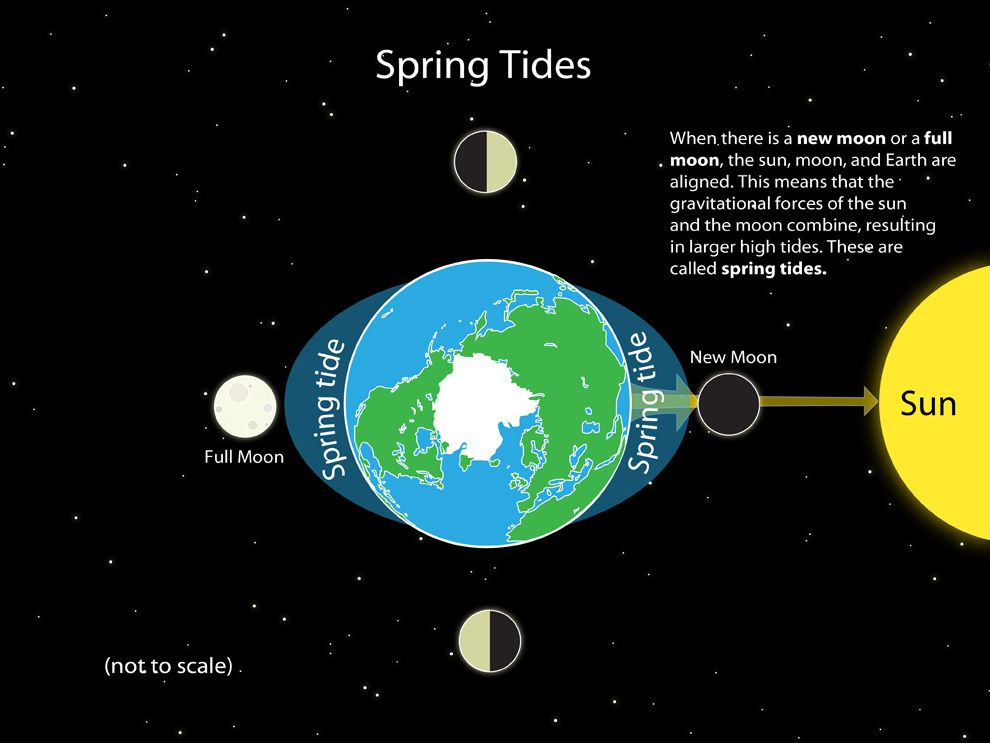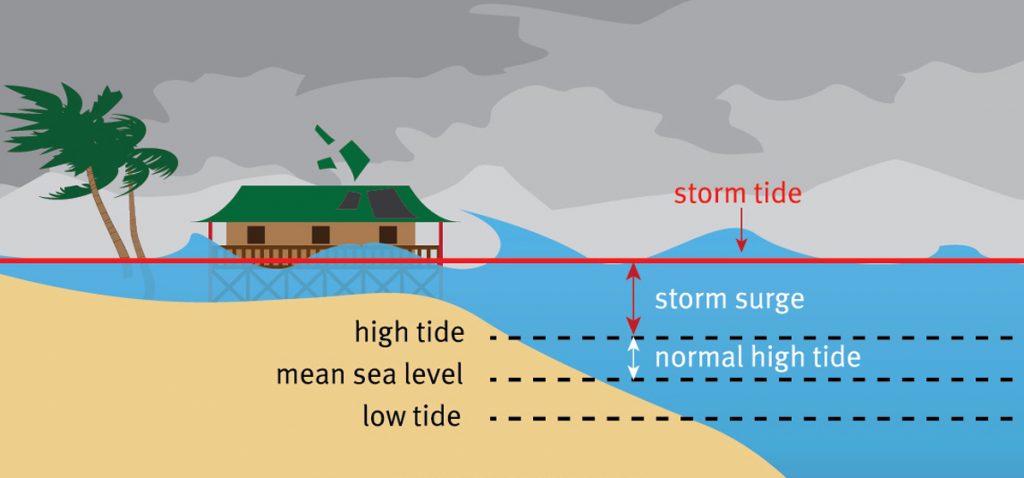Types of Tides: Understanding Their Differences and Causes
Tides are one of the most fascinating natural phenomena observed on Earth, influenced by the gravitational pull of the moon and sun. They play a crucial role in marine life and impact human activities along coastlines.

Understanding the different types of tides can help us better predict and adapt to these changes in sea level.
There are four main types of tides: diurnal, semidiurnal, mixed, and macro.
Diurnal tides have one high and one low tide each day, while semidiurnal tides experience two high and two low tides daily.
Mixed tides show a combination of characteristics, and macro tides are unusually large tides occurring in specific locations.
Factors like the shape of the sea floor and Earth's rotation also influence tidal patterns.

Geographic locations further affect how often and how significantly these tides occur.
These variations are essential for studying ecological systems and planning coastal activities.
Key Takeaways
- Tides are influenced by the gravitational pull of the moon and sun.
- There are four main types of tides: diurnal, semidiurnal, mixed, and macro.
- Geographic and physical factors impact the occurrence and intensity of tides.
Fundamentals of Tides
Tides are complex phenomena influenced by various factors such as the Moon, the Sun, and Earth's gravitational forces. Understanding these elements helps explain the rise and fall of ocean levels.
The Role of the Moon and Sun
The Moon and the Sun are the primary drivers of tides.
The Moon's gravitational pull has the most significant effect due to its proximity to Earth. When the Moon is directly overhead or on the opposite side of Earth, it causes bulges in the ocean, leading to high tides.
The Sun also affects tides but to a lesser extent.
When the Earth, Moon, and Sun align during full moons and new moons, their combined gravitational forces produce very high and very low tides, known as spring tides.
Conversely, when the Sun and Moon are at right angles, they create neap tides, which have a smaller tidal range.

Tidal Range and Tidal Cycles
The tidal range is the difference in height between consecutive high and low tides. Tidal ranges vary around the world and are influenced by the positions of the Moon and Sun.
For example, the Bay of Fundy in North America has one of the highest tidal ranges globally.
Tidal cycles typically follow a pattern over approximately 24 hours and 50 minutes. This cycle includes two high tides and two low tides in most coastal areas, known as semidiurnal tides.
In contrast, some regions experience diurnal tides, with one high tide and one low tide per day, such as in the Gulf of Mexico.
Gravitational Forces and Bulges
Gravitational forces between the Earth, Moon, and Sun create tidal bulges in Earth's oceans. These bulges are the areas where high tides occur.
When the side of Earth facing the Moon and the opposite side experience these bulges, there are simultaneous high tides on opposite sides of the planet.
Between these high-tide bulges are areas where low tides occur. The gravitational pull decreases, causing the seas to fall.
Types of Tides
Understanding the types of tides is essential for navigators, fishermen, and environmentalists. Tides are influenced by the positions of the Moon, Sun, and Earth, as well as geographical factors.
Spring and Neap Tides
Spring tides occur when the Sun, Moon, and Earth align in a straight line. This alignment happens during the full moon and new moon phases. Spring tides produce the highest high tides and the lowest low tides.
Neap tides happen when the Sun and Moon are at right angles to each other. This occurs during the first and third quarters of the moon. Neap tides result in the least difference between high and low tides.
Both spring and neap tides follow a two-week cycle. Their patterns can be predicted with reasonable accuracy, making them important for coastal activities.

Diurnal, Semidiurnal, and Mixed Tides
Diurnal tides occur once every tidal day, which means there is one high tide and one low tide each day. These are common in parts of the Gulf of Mexico and Southeast Asia.
Semidiurnal tides have two high tides and two low tides every 24 hours. They are most common on the Atlantic coasts of North America and Europe.
Mixed tides show characteristics of both diurnal and semidiurnal tides. They include two high tides and two low tides of different heights within the same day. This type is often found along the Pacific coast of North America.

Tides in Oceans and Seas
Ocean tides are primarily driven by the gravitational forces of the Moon and the Sun. They are most noticeable in open ocean areas but also extend to coastal regions.
Seas experience tides similarly to oceans but the effects can vary due to the smaller size and different depths.
The Mediterranean Sea, for instance, has relatively minor tidal changes due to its restriction by landmasses on nearly all sides.
Monitoring tides in oceans and seas is crucial for navigation and environmental conservation. Accurate tide tables help mariners avoid dangerous conditions and help scientists understand oceanic processes.

Tides in Lakes and Rivers
Lakes generally experience very small tidal changes due to their limited size and volume. Notable exceptions include large bodies of water like the Great Lakes, which can show measurable but small tidal variations.
Rivers can experience tidal effects, especially near their mouths where they meet the sea.
These tides can influence river flow and sediment transport, and create phenomena like tidal bores in some rivers. Tidal bores are sudden increases in water level caused by the incoming tide.

Physical Characteristics of Tides
Tides are influenced by cyclical movements and gravitational forces. Key elements include the ebbing and flowing of water, variations in high and low water marks, and the movement of tidal currents.
Ebb and Flow
Ebb and flow describe the movement of water during a tidal cycle.
When the tide is coming in, it is rising or flooding. This is the flow. Conversely, the ebb is when water levels recede or fall.
Ebb and flow cycles are affected by the gravitational pull of both the Moon and the Sun.
The ocean waters are pulled towards these celestial bodies, causing the regular rise and fall.
The shape of the coastline and sea floor can also influence the intensity and timing of ebb and flow. They are essential to coastal ecosystems and navigation.

High Water and Low Water
High water marks the point when the tide reaches its maximum height. Low water is the lowest level reached during a tidal cycle. These points are known as high tide and low tide, respectively.
High tides occur when the gravitational forces of the Moon and Sun align to pull ocean waters towards them.
Low tides happen when these forces pull water away from the shore. The difference in height between high and low tide is called the tidal range.
Coastal geography can enhance or diminish these effects. Understanding these patterns is critical for coastal planning and marine activities.
Tidal Currents
Tidal currents are the horizontal flow of water associated with the rise and fall of tides. These currents are most noticeable in narrow channels and shallow waters where they can be quite strong.
The speed and direction of tidal currents change with the tide.
During flood tide, currents flow towards the shore. During ebb tide, currents move away from the shore.
Tidal currents can impact navigation, marine life, and sediment transport. Accurately predicting them is vital for safe maritime operations and environmental management.

Geographic Impact on Tides
The shape of the coastline and ocean basins influences the tides. Some bays and inlets can amplify tidal range, leading to higher high tides and lower low tides.
Tides in Different Ocean Basins
Ocean basins like the Pacific, Atlantic, and Indian Oceans experience varying tidal effects due to their unique shapes and sizes.
The shape of an ocean basin can amplify or dampen the range of tides experienced along the coastline.
For instance, the Bay of Fundy in North America has one of the highest tidal ranges in the world due to its funnel-like shape.
In contrast, the Gulf of Mexico sees relatively modest tidal changes because it is a more enclosed body of water.
Other regions, such as the coastlines of the United Kingdom, experience mixed tides where the pattern alternates between diurnal (one high and one low tide per day) and semi-diurnal (two high and two low tides per day) due to the complex interaction of ocean currents and the shape of the seabed.
Impact on Shorelines and Coastlines
Shorelines and coastlines are profoundly affected by the tides' rise and fall. For example, tidal forces can lead to the formation of tidal pools and estuaries.
On the East Coast of North America, the varying tides influence the extent of salt marshes and mudflats, providing habitats for various species.
In China's Qiantang River, a tidal bore occurs where incoming tides form a wave that travels up the river, influencing local ecology and navigation.
Similarly, coastal areas in Europe and Australia experience significant tidal impacts, shaping shorelines and affecting human activities like fishing and shipping.
Tidal Phenomena and Special Tides
Tidal phenomena encompass unique and sometimes dramatic occurrences that go beyond regular tidal patterns. These special tides can affect coastal areas significantly, and it's important to understand them.
King Tides and Perigean Spring Tides
King tides are exceptionally high tides that occur when the sun and moon align and their gravitational forces combine. These usually happen a few times a year and can lead to coastal flooding.
Perigean spring tides occur when the moon is closest to Earth, known as perigee, amplifying the usual spring tides. These tides are also unusually high and can cause similar issues as king tides.
Both phenomena are natural and predictable, making it easier for coastal communities to prepare for potential impacts like flooding and erosion.
Rip Tides and Red Tides
Rip tides, also known as rip currents, are powerful, narrow currents that flow away from the shore. They can be dangerous for swimmers and can form unexpectedly, pulling people out to sea. They are not caused by tides but by wind and wave conditions.
In contrast, red tides are harmful algal blooms that discolor the water and can produce toxins harmful to marine life and humans. These blooms are influenced by nutrient levels in the water and can be exacerbated by certain tidal conditions, leading to massive die-offs of fish and other marine organisms.
Atmospheric and Earth Tides
Atmospheric tides are oscillations in the Earth's atmosphere caused by the gravitational pull of the moon and sun. They can influence weather patterns and the behavior of the ionosphere, affecting radio communications and satellite operations.
Earth tides, on the other hand, refer to the slight elastic deformation of the Earth's crust. These are less noticeable but are still the result of the gravitational forces exerted by celestial bodies. They play a role in tectonic activities and can affect the accuracy of GPS systems.
Ecological and Biological Aspects
Tides play a crucial role in shaping marine ecosystems. They also significantly affect the intertidal zone, influencing both the physical environment and the organisms that inhabit these areas.
Impact on Marine Ecosystems
Tides are essential for the health of marine ecosystems. They facilitate nutrient mixing, which is vital for primary production.
When tides rise and fall, they help distribute nutrients and oxygen throughout the water column. This process supports plankton growth, a base food source for many marine animals.
Tidal movements also help remove waste products from coastal areas, maintaining water quality.
In addition, tides affect sea levels, which in turn influence habitats such as coral reefs and mangroves. These environments rely on specific tidal patterns to maintain their health. Without regular tidal flow, these ecosystems could suffer from stagnant water and a lack of nutrients.
Tidal Influence on Intertidal Zone
The intertidal zone, the area between high and low tide lines, is heavily influenced by tidal patterns. Here, organisms must adapt to extreme changes in water levels and exposure to air.
Animals such as crabs, mollusks, and starfish have developed unique adaptations to survive these conditions. For instance, some have shells that can close tightly to prevent dehydration during low tide.
Sea levels and tidal cycles also determine the types of plants and animals that can thrive in this zone.
For example, seaweeds and certain algae grow in areas regularly submerged by tides. These plants provide essential shelter and food for various marine species.
Scientific Study and Understanding
Scientists have worked to measure and predict tides accurately, which has significant historical and cultural importance. Reliable phenomena in tides help maritime navigation and coastal activities.
Measuring and Predicting Tides
Tides are measured using tide gauges placed along coastlines. These devices record the rise and fall of water levels over time.
Data from these measurements are used to make accurate tide predictions. Advances in satellite altimetry have further improved tidal measurement by tracking sea level changes from space.
Accurate tide predictions are essential for activities such as shipping, fishing, and coastal management.
Reliable phenomena like tidal cycles help predict when high and low tides will occur. This information is crucial for preventing accidents and managing natural resources effectively.
Some areas experience unique tidal patterns due to their geographical features, which scientists study to understand better.
Historical and Cultural Significance
Throughout history, tides have had a significant impact on coastal communities. In ancient times, people used tides to time their fishing and trade activities.
Many cultures developed myths and legends explaining the cause of tides, often attributing them to the actions of gods or supernatural forces.
Historic records and observations have been invaluable to scientists trying to understand long-period waves and tidal phenomena.
For example, the Bay of Fundy in Nova Scotia, Canada, has the highest tidal range globally, which has fascinated researchers and locals alike. These high tides have shaped the region’s culture and economy, influencing everything from fishing to tourism.
The study of tides also has navigational importance. Early sailors relied on understanding tides to avoid being stranded or navigating tricky coastal waters. Knowledge of the tides was crucial for the success of many historical voyages and expeditions.
Global Effects and Climatic Interactions
Tides are influenced by various global factors and climatic interactions. These include the Coriolis Effect, the position of amphidromic points, and interactions within the solar system. This impacts tidal patterns and variations across the planet.
Coriolis Effect and Tidal Patterns
The Coriolis Effect arises due to Earth’s rotation. It impacts moving water bodies, causing them to deflect to the right in the Northern Hemisphere and to the left in the Southern Hemisphere. This deflection alters tidal movements and patterns significantly.
This phenomenon affects ocean currents and can lead to variations in sea levels.
Regions on either side of the equator exhibit different tidal behaviors because of this effect. Coastal areas, especially near large oceanic gyres, experience noticeable changes in tide heights and periodicity.
Amphidromic Points and Tidal Variations
Amphidromic points are locations in the ocean where the tidal range is essentially zero. Around these points, the tide rotates counterclockwise in the Northern Hemisphere and clockwise in the Southern Hemisphere. They are crucial in understanding tidal variations.
The number and location of these points impact the amplitude and phase of tides in surrounding coastal areas.
Countries with coastlines near amphidromic points may have unique tidal patterns, with some experiencing smaller tidal ranges while others see more pronounced variations.
Solar System Interactions and Solar Tides
The gravitational pull of the Sun and Moon primarily causes tides. The Sun’s effect, though less than the Moon’s, still significantly influences tidal patterns, creating what are known as solar tides.
During specific alignments, such as new and full moons, the combined gravitational forces of the Sun and Moon result in spring tides, which are exceptionally high tides.
Conversely, during the first and third quarters of the Moon, the two bodies' gravitational forces partially cancel each other out, leading to neap tides, which have a smaller tidal range.
These solar system interactions ensure that tidal patterns not only vary daily but also over longer periods, linked to the lunar cycle and Earth's orbit.
Frequently Asked Questions
This section covers key questions about the causes of different tides, their variations, and their relationship with the moon's phases.
What causes the different types of tides in the ocean?
Tides are caused by the gravitational pull of the moon and the sun. This pull creates bulges in the ocean, leading to high and low tides. The Earth's rotation also plays a role in the timing of these tides.
How do semidiurnal and diurnal tides differ?
Semidiurnal tides have two high tides and two low tides each day. Diurnal tides have only one high tide and one low tide per day. Different regions of the world experience these tides based on their geographic location.
What is the significance of the moon's phases in relation to tides?
The moon's phases affect the tides' heights. During the full and new moons, the gravitational pull is stronger, creating higher high tides and lower low tides, known as spring tides. During the first and third quarters, this pull is weaker, resulting in neap tides.
What is a neap tide and when does it occur?
A neap tide occurs during the first and third quarters of the moon. During these times, the gravitational forces of the moon and the sun are perpendicular to each other, causing the least difference between high and low tides.
How can you distinguish between spring tide and neap tide?
Spring tides have the highest high tides and the lowest low tides. They occur during the full and new moon phases. Neap tides have the least variation between high and low tides and occur during the first and third quarters of the moon's phase.
What factors contribute to the variations in tide levels around the world?
Geographic location plays a major role.
Coastal shape, ocean basin topography, and local wind and weather conditions can all affect tide levels.
Some regions experience larger tidal ranges because of these combined factors.
Explore more about tides and their workings.
Charlie is Editor-in-Chief of Sea Magazine







